Location :
Significance of the temple
This vast temple covers an area roughly of about 40 acres and is one of ancient temple reported to be in existence from the year 600 AD. Pallava, Chola and Vijanagara Kings have contributed to the building of the temple. The presiding deity Lord Shiva is worshipped here as Prithvi Lingam (Lingam of Earth). There is no particular seperate shrine for the Female deity as is customary in all the Shiva Temples found in Kancheepuram. All the 4 famous Saivite Saints, Appar, Sambandar, Manickavasgar and Sundarar have sung the glory of this temple.
There is also a sacred mango tree inside the temple which is supposed to be more than 3000 years old. This tree is the Sthala Vruksham (Temple Tree) of this temple. There are four branches of this tree representing the 4 Vedhas and the tree bears 4 different types of mango fruits in 4 different seasons. Goddess Parvathi, was once seperated from her husband, came to Kancheepuram and made a Sivalingam out of sand and installed it under a mango tree on the banks of a river and worshipped it and got Shiva's hand in marriage.
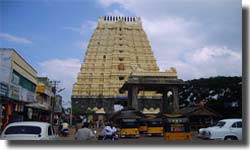
There are several Shiva temples which are scattered all over Kanchipuram, and it is to be noted that there is no separate shrine for Parvati in any of them. The Kamakshiamman temple is the only Ambal shrine in Kanchipuram. In Kanchi, the Ekambreswarar, Kamakottam temples with Kumarakottam in between usually denote Somaskandar.
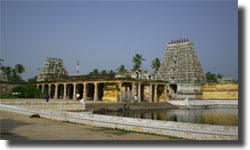
The Pallavas, Cholas and the Vijayanagar Kings especially Krishna Deva Raya have contributed to this temple. Second century AD Tamil poetry speaks of Kamakottam, and the Kumarakottam (currently the Kamakashi Amman temple and the Subramanya temple). Tiruvacakam, Tirukkovaiyaar, Kanchipuranam, Manimekalai etc., speak of the glory of Kanchi, the city.The existing structure then, was pulled down and rebuilt by the Pallava Kings. The Cholas who came in later also made several contributions to the temple.
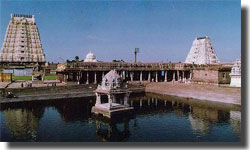
The presiding deity here is known as the Ekambareswarar or Shiva, worshipped as the Prithivi Lingam. A Somaskanda panel featuring Shiva, Parvati and Skanda adorns the rear of the main shrine, which has been held in worship for centuries together. It is believed that Parvati, the consort of Shiva worshipped him in the form of a Prithivi Lingam, or a Lingam improvised out of sand, under a mango tree.
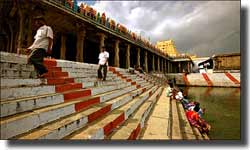
There is another shrine of Shiva and Kamakshi under the Stala Vruksham or the Temple tree, which is a mango tree said to be 3500 years old. The mango tree is said to be the embodiment of the four Vedas and the tree is said to bear fruits of four different tastes each season here. The Saint poet Sundaramoorthy Nayanar is said to have been recovered his eyesight (left eye) after offering worship here.
Festivals and Services
Six worship services are offered each day in this temple - namely UshadKalam, Kaalasanthi, Uchi Kaalam, Pradosham and Sayarakshai and Ardhajamam. Colorful festivals are being celebrated such as Ani Tirumanjanam (June-July), Adi Kritikai (July-Aug), Avani Moolam (Aug - Sep), Navaratri (Sep-October), Kartikai Deepam (Nov-Dec), Thai Poosam (Jan-Feb), Panguni Uthiram (Mar-Apr), Chitra Pournami (Apr-May) and Vaikashi Vishakam (May-June) marking the temple's annual calendar. The Panguni festival lasts for 13 days and it is during this festival that the wedding of the presiding deity is celebrated, and the venerated Tamil poems of the Nayanmars (Tirumurais) are sung in great splendor. Nilaathungal Tunda Perumaal - Vishnu is worshipped in a small shrine in one of the corridors.The works of the Alwars refer to the Vishnu shrine here and it is revered as one of the 108 Divya Desams as well.
Sri Ekambareswara Temple is the most famous Shiva temple at Kanchi where Lord Shiva is worshipped in the form of Prithivi Linga (Earth Linga). This temple was built around 600 AD and there is no separate shrine for Parvati here.
Legend of Ekambareswarar temple
The Sthala Purana says that when Lord Shiva was deeply immersed in the task of creating, protecting and destroying the Universe, Parvati, his consort, in a jocular mood, closed his eyes. This resulted in staying the process of creation and destruction as well as obstruction to the natural law of things. It was a serious matter and Shiva became angry and cursed Parvati to go to the Earth and expiate her misdeed. Accordingly Parvati came to the banks of the river Kampa under a single mango tree at Kanchi and made a Shivalinga out of sand and worshipped it. To test her sincerity Shiva placed various obstacles and hindrances in the way of Parvati`s penance. But with the help of Lord Vishnu she could tide over all the difficulties. At last Shiva hurled a deluge by taking out the River Ganges from his matted hair, to wash away the Linga worshipped by Parvati. She clasped it with all veneration to her breasts and this pleased Shiva who took her again as his consort.Architecture of Ekambareswarar Temple
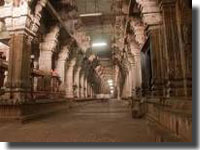
A Somaskanda panel features Shiva, Parvati and Skanda on the rear of the main shrine. Six worship services are offered in the temple of Sri Ekambareshwar Temple every day. They are known as "UshadKalam", "Kaalasanthi", "Uchi Kaalam", "Pradosham", "Sayaratchai" and "Ardhajamam".
Time to Visit
Several festivals throng the calendar of the temple throughout the year. The Phalguni Festival is the most important temple festival of Lord Ekambareswar. It is celebrated for a period of 13 days and it is during this festival that the wedding of Shiva and Parvati are performed.
| Near by tourist places to Ekambareswarar Temple Chennai Kanchipuram Mahabalipuram |
 |
How to reach the Temple
- Through Airways -Chennai, the nearest international airport, is situated around 75 km away from Kanchipuram.Both public and private transport facilites are available at the airprot.
- Through Railways -Kanchipuram is connected with the southern part of the rail network and few trains are running through Kanchipuram. Suburban trains are running between Kanchipuram and Chennai beach on specified intervals.
- Through Roadways -the city of Kanchipuram is well connected with the other part of the states and it is few kms from the Quadrilateral National Highway. There are frequent bus services from Chennai and it takes 2- 3 hours. The Chennai Metropolitian and the state express transport operate the services.



